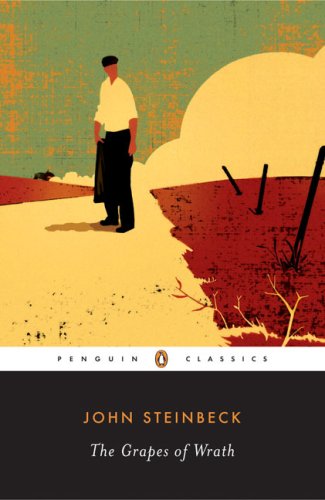
Today, nearly forty years after his death, Nobel Prize winner John Steinbeck remains one of America’s greatest writers and cultural figures. Over the next year, his many works published as black-spine Penguin Classics for the first time and will feature eye-catching, newly commissioned art.
The Grapes of Wrath is a landmark of American literature. A portrait of the conflict between the powerful and the powerless, of one man’s fierce reaction to injustice, and of one woman’s stoical strength, the novel captures the horrors of the Great Depression and probes into the very nature of equality and justice in America. Although it follows the movement of thousands of men and women and the transformation of an entire nation, The Grapes of Wrath is also the story of one Oklahoma family, the Joads, who are driven off their homestead and forced to travel west to the promised land of California. Out of their trials and their repeated collisions against the hard realities of an America divided into Haves and Have-Nots evolves a drama that is intensely human yet majestic in its scale and moral vision, elemental yet plainspoken, tragic but ultimately stirring in its human dignity.
First published in 1939, The Grapes of Wrath summed up its era in the way that Uncle Tom’s Cabin summed up the years of slavery before the Civil War. Sensitive to fascist and communist criticism, Steinbeck insisted that “The Battle Hymn of the Republic” be printed in its entirety in the first edition of the book—which takes its title from the first verse: “He is trampling out the vintage where the grapes of wrath are stored.” At once a naturalistic epic, captivity narrative, road novel, and transcendental gospel, Steinbeck’s fictional chronicle of the Dust Bowl migration of the 1930s is perhaps the most American of American Classics.
When The Grapes of Wrath was published in 1939, America, still recovering from the Great Depression, came face to face with itself in a startling, lyrical way. John Steinbeck gathered the country’s recent shames and devastations–the Hoovervilles, the desperate, dirty children, the dissolution of kin, the oppressive labor conditions–in the Joad family. Then he set them down on a westward-running road, local dialect and all, for the world to acknowledge. For this marvel of observation and perception, he won the Pulitzer in 1940.
The prize must have come, at least in part, because alongside the poverty and dispossession, Steinbeck chronicled the Joads’ refusal, even inability, to let go of their faltering but unmistakable hold on human dignity. Witnessing their degeneration from Oklahoma farmers to a diminished band of migrant workers is nothing short of crushing. The Joads lose family members to death and cowardice as they go, and are challenged by everything from weather to the authorities to the California locals themselves. As Tom Joad puts it: “They’re a-workin’ away at our spirits. They’re a tryin’ to make us cringe an’ crawl like a whipped bitch. They tryin’ to break us. Why, Jesus Christ, Ma, they comes a time when the on’y way a fella can keep his decency is by takin’ a sock at a cop. They’re workin’ on our decency.”
The point, though, is that decency remains intact, if somewhat battle-scarred, and this, as much as the depression and the plight of the “Okies,” is a part of American history. When the California of their dreams proves to be less than edenic, Ma tells Tom: “You got to have patience. Why, Tom–us people will go on livin’ when all them people is gone. Why, Tom, we’re the people that live. They ain’t gonna wipe us out. Why, we’re the people–we go on.” It’s almost as if she’s talking about the very novel she inhabits, for Steinbeck’s characters, more than most literary creations, do go on. They continue, now as much as ever, to illuminate and humanize an era for generations of readers who, thankfully, have no experiential point of reference for understanding the depression. The book’s final, haunting image of Rose of Sharon–Rosasharn, as they call her–the eldest Joad daughter, forcing the milk intended for her stillborn baby onto a starving stranger, is a lesson on the grandest scale. “‘You got to,'” she says, simply. And so do we all. –Melanie Rehak

TRULY A “MASTERPIECE” I don’t know how anyone could read this book and not give it a five star rating. The true test for me of a “great book” is one that stays with me — one I can’t stop thinking about long after I’ve finished. I read this book for the second time in my life a month ago (first time was in high school many years ago), and I’m still haunted by the suffering endured by the Joad family. The interesting thing is that Steinbeck wrote this book in 1939 at the height of the injustices being…
Read this book — it’s astounding I can’t remember the last time I was moved so profoundly by a work of fiction. I finished the book two weeks ago and have not been able to stop talking or thinking about it. Read this book. It will truly change the way you view the world.